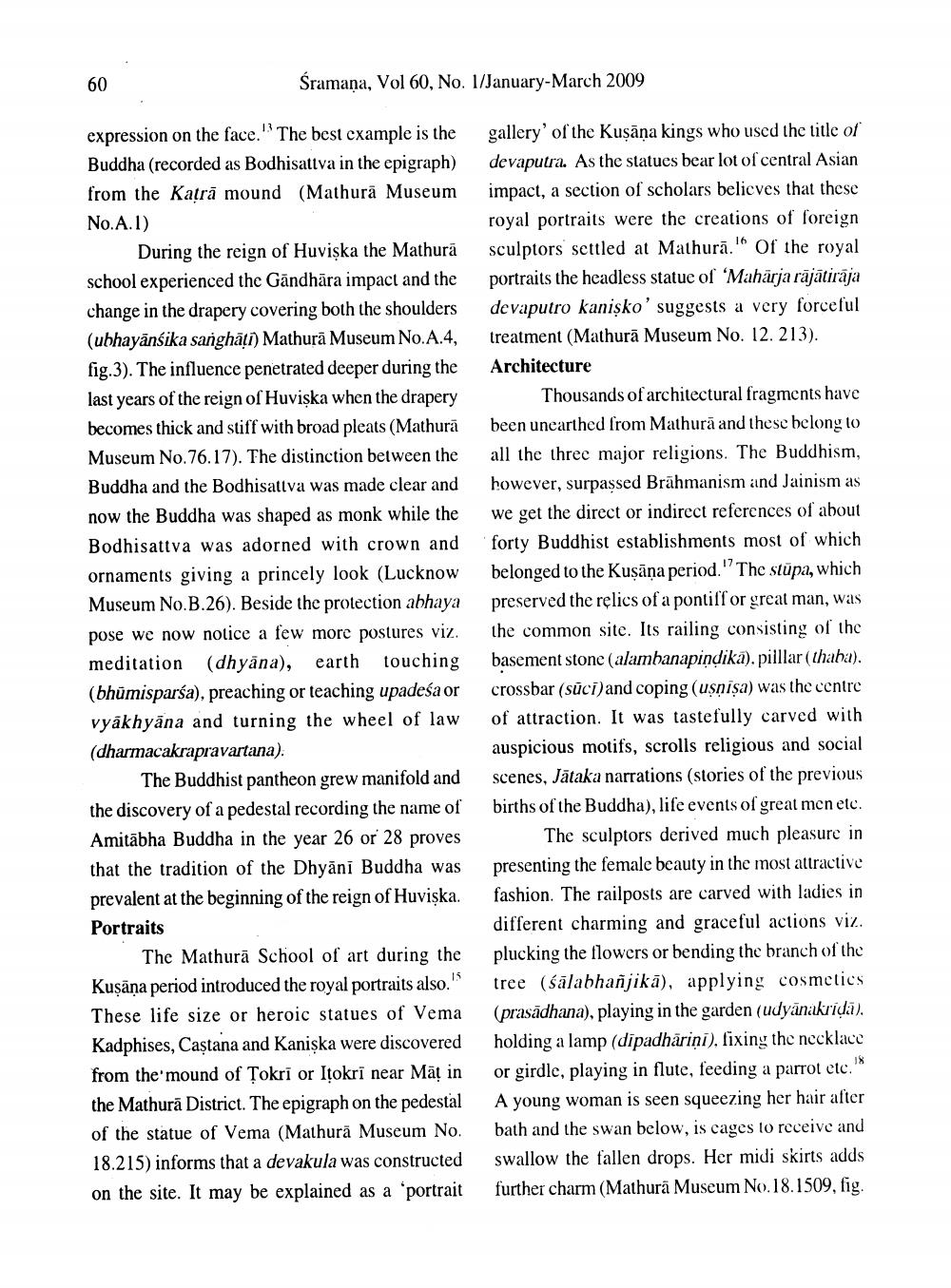________________
60
Śramaņa, Vol 60, No. 1/January-March 2009
expression on the face." The best example is the Buddha (recorded as Bodhisattva in the epigraph) from the Katrā mound (Mathurā Museum No.A.1)
During the reign of Huviska the Mathură school experienced the Gāndhāra impact and the change in the drapery covering both the shoulders (ubhayānsika sanghāti) Mathurā Museum No.A.4, fig.3). The influence penetrated deeper during the last years of the reign of Huviska when the drapery becomes thick and stiff with broad pleats (Mathurā Museum No.76.17). The distinction between the Buddha and the Bodhisattva was made clear and now the Buddha was shaped as monk while the Bodhisattva was adorned with crown and ornaments giving a princely look (Lucknow Museum No.B.26). Beside the protection abhaya pose we now notice a few more postures viz. meditation (dhyāna), earth touching (bhūmisparśa), preaching or teaching upadeśa or vyakhyāna and turning the wheel of law (dharmacakrapravartana).
The Buddhist pantheon grew manifold and the discovery of a pedestal recording the name of Amitabha Buddha in the year 26 or 28 proves that the tradition of the Dhyāni Buddha was prevalent at the beginning of the reign of Huviska. Portraits
The Mathurā School of art during the Kuşāņa period introduced the royal portraits also." These life size or heroic statues of Vema Kadphises, Castana and Kaniska were discovered from the mound of Tokrī or Itokrī near Māļ in the Mathurā District. The epigraph on the pedestal of the statue of Vema (Mathura Museum No. 18.215) informs that a devakula was constructed on the site. It may be explained as a 'portrait
gallery of the Kuşāņa kings who used the title of devaputra. As the statues bear lot of central Asian impact, a section of scholars believes that these royal portraits were the creations of foreign sculptors settled at Mathurā.'' Of the royal portraits the headless statue of 'Mahārja rājātirāja devaputro kanisko' suggests a very forceful treatment (Mathurā Museum No. 12. 213). Architecture
Thousands of architectural fragments have been unearthed from Mathurā and these belong to all the three major religions. The Buddhism, however, surpassed Brāhmanism and Jainism as we get the direct or indirect references of about forty Buddhist establishments most of which belonged to the Kuşāņa period." The stūpa, which preserved the relics of a pontisfor great man, was the common site. Its railing consisting of the basement stone (alambanapindika), pilllar (thaba). crossbar (sūci)and coping (uşnişa) was the centre of attraction. It was tastefully carved with auspicious motifs, scrolls religious and social scenes, Jātaka narrations (stories of the previous births of the Buddha), life events of great men etc.
The sculptors derived much pleasure in presenting the female beauty in the most attractive fashion. The railposts are carved with ladies in different charming and graceful actions viz. plucking the flowers or bending the branch of the tree (śālabhanjikā), applying cosmetics (prasādhana), playing in the garden (udyānakriļā). holding a lamp (dipadharini), fixing the necklace or girdle, playing in flute, feeding a parrot etc." A young woman is seen squeezing her hair after bath and the swan below, is cages to receive and swallow the fallen drops. Her midi skirts adds further charm (Mathura Museum No.18.1509, fig.




